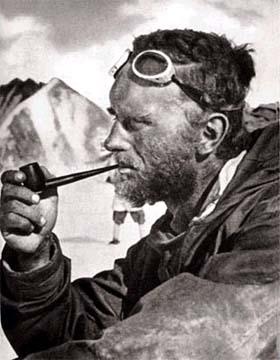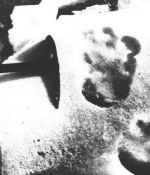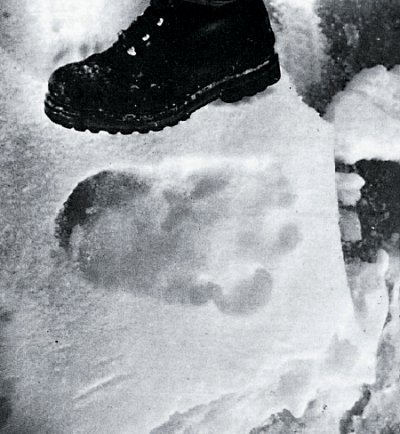
September 6, 2007

Eric Shipton, above, (August 1, 1907 – March 28, 1977), has a name that will live on forever within cryptozoology, in conjuction with the famed “1951 Shipton Yeti footprints photos.” Shipton found these tracks during his exploratory 1951 expedition in which he and his team worked out the now famous route over the Khumbu Glacier to assault Mount Everest.
I thought the death on October 7, 2005, of Michael Ward, 80, closed a living chapter of that remarkable event and soon thereafter, more might be heard from Ward’s or Shipton’s estates. Ward was the medical doctor, along with Eric Shipton, who photographed these now well-known Yeti (Abominable Snowman) tracks in the Himalaya, in 1951. (See also Ward obit.)
Perhaps what is occurring this month is the result. Many credit Ward with taking the actual photographs of these Yeti imprints, not Shipton. It only makes sense the originals would turn up sooner than later, after Ward’s passing.

One or two of those photographs are often shown, but as you can see from some I have gathered here, there is a diversity to the shoots and the framing. A partial footprint is visible in one, a trackway in another, an ice ax used for scale in a photo, and a boot in another. The small collection is on the auction block and a new individual will own a significant piece of Yeti exploration history after September 26, 2007.

Now a two-day Christie’s sale has been announced in which the rare originals of these photographs are being auctioned. These are important historical pieces to cryptozoological history, and I certainly hope they are obtained by someone who will share them for research purposes, at least.

The London newspaper, The Telegraph detailed the sale and had this, in part, to say about it:
The first photographic evidence that the yeti, or abominable snowman, might be more than a flight of Himalayan fancy has surfaced in public and is to be offered at auction later this month.
Four photographs of large paw prints in the snow beneath Mount Everest are to be sold at Christie’s in London on September 26.
The images were taken by the legendary British mountaineer Eric Shipton on a reconaissance trip to Everest in 1951, in preparation for the first successful ascent of the 29,028 ft peak two years later.
Tom Bourdillon, who was also in the reconaissance party, later gave Shipton’s black and white prints, which measure 6ins by 4ins, to a friend, Michael Davies.
Mr Davies’ descendants are now selling the historic souvenirs, which are expected to fetch £2,500.
The first European claim of a sighting of a large bear-like beast in the Himalayas was made in 1925, but there was no photographic back-up until Shipton’s pictures.
On the back of one of his images, Bourdillon wrote to Davies about the team’s sighting of the prints.
He said: “We came across them on a high path on the Nepal-Tibet watershed during the 1951 Everest expedition.
“They seem to have come over a secondary path at about 19,500ft down to 19,000ft where we first saw them and then went on down the glazier.
“We followed them for the better part of a mile. What it is I don’t know, but I am quite clear that it is no animal known to live in the Himalaya and that it is big.”
Edmund Hillary, who first climbed the mountain with Tenzing Norgay, later said in a book that a member of his successful party had found a tuft of long black hairs on a rock. The hairs were said to look like bristles.
Publication of Shipton’s pictures prompted several expeditions to search for the yeti but they all proved to be inconclusive.“Yeti footprint photos go under the hammer,”by Nigel Reynolds, Arts Correspondent, The Telegraph, London, UK, September 4, 2007.
If Cryptomundo learns whom the new owner is, you will be the first to know.

About Loren Coleman
Loren Coleman is one of the world’s leading cryptozoologists, some say “the” leading living cryptozoologist. Certainly, he is acknowledged as the current living American researcher and writer who has most popularized cryptozoology in the late 20th and early 21st centuries.
Starting his fieldwork and investigations in 1960, after traveling and trekking extensively in pursuit of cryptozoological mysteries, Coleman began writing to share his experiences in 1969. An honorary member of Ivan T. Sanderson’s Society for the Investigation of the Unexplained in the 1970s, Coleman has been bestowed with similar honorary memberships of the North Idaho College Cryptozoology Club in 1983, and in subsequent years, that of the British Columbia Scientific Cryptozoology Club, CryptoSafari International, and other international organizations. He was also a Life Member and Benefactor of the International Society of Cryptozoology (now-defunct).
Loren Coleman’s daily blog, as a member of the Cryptomundo Team, served as an ongoing avenue of communication for the ever-growing body of cryptozoo news from 2005 through 2013. He returned as an infrequent contributor beginning Halloween week of 2015.
Coleman is the founder in 2003, and current director of the International Cryptozoology Museum in Portland, Maine.
Filed under Abominable Snowman, Artifacts, Breaking News, Cryptotourism, CryptoZoo News, Cryptozoologists, Cryptozoology, Expedition Reports, Eyewitness Accounts, Media Appearances, Men in Cryptozoology, Obituaries, Photos, Pop Culture, Year In Review, Yeti